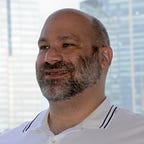--
Along the arc of my career, I have spent a lengthy amount of time specifically focused on diversity and inclusion related topics. One of my Master’s degrees included a fellowship directly focused on diversity leadership and inclusion. After all that, I recognize that the central theme to the ‘Geriatric Millennials’ conversation is bias.
How geriatric do you have to be in order to be considered geriatric? Aging between 36–41 is now considered old? That’s astounding. And what is the qualifying metric for workers aged 42+ to be termed “less tech savvy”? Are you focusing just on the social media aspect? Knowledge of messaging apps? Data visualization platforms? Would someone whose public facing persona produces content on all these platforms qualify?:
Would it shock you to know that person is a GenX-er?:
The reality of the geriatric millennial diatribe is that it sits squarely on a platform of bias. Ageism, equivalently to racism, anti-Semitism, sexism, LGBTQIA+ discrimination, and the entire range of -isms is precisely that: an -ism that has no place in a more open, more accepting (as opposed to just tolerant), more progressive society. That society is right where the geriatric millennials reportedly claimed they would like to be in every article since they graduated high school. They want to have work with ‘purpose’, and that adheres to ESG standards. But even one of the most important documents associated with ESG: the UN Sustainable Development Goals, defines elimination of bias as critical to equity, equality, and the advancement of all humans on the planet. Diversity is not just of nationalities, ethnicities, and religions, it’s also of age bands.
In stark contrast, bias, and overt hatred based on bias is what led to things like the Holocaust, the current plight in Gaza, the Turkish Armenian war, the attempted extermination of Uighurs and Kurds, and current violence against indigenous people in Latin America. Bias (of a political sort, strongly centered on a white supremacist nationalism) is what led to the January 6 storming of the US Capitol.
The second atrocity in the foregoing article is the over reliance on technology as a qualifier for “leadership.” Technology — as you are also finding out with your own cohort — ages out. At the same time, and more pernicious, is how disparity causing technology actually is. Some would call it divisive. In fact, the digital divide is something that — during the pandemic — reared it’s ugly head to demonstrate vast fault lines between the haves and the have nots. While digital literacy is a critically important societal issue to address (again, a social ill Millennials have sworn to undo!) mean-girling about being able to flex for the Gram, complete Tik Tok challenges, or how you totally kept that one person out of the Clubhouse chat while your office counterparts can’t see the point doesn’t create a professionally positive portrayal of your mental schema.
Remember for two seconds about the first round of fiscal stimulus provided in response to the pandemic. The entire reason those checks arrived? The IRS had to call back an army of GenX coders who remembered COBOL — an ancient coding language on which the disbursement platform had been based. There’s no YouTube video for that. While the total stimulus check was a distressingly low amount, the reason the money went out at all was not because of Millennials’ “tech savvy.” It was age and experience.
Another tech truism: rate of adoption for any new widget is directly proportional to how willing the guru is to engage directly with the non-gurus and ensure comfort level, alignment with business objectives, and reduction of friction points. How much of that have you done today?
Here too is another frequently touted solution by Millennials themselves which seems to be wholly absent from the entire painted panorama — reverse mentorship. You want a specific technology adopted, utilized, deployed to a business unit? Show me how it works and why it’s a necessary time sink from my already overloaded work day. Give me a primer on how to get better at it. But that’s not coming through when you’re busy claiming “we’re cooler because our toys are more tech-y than yours.” To connect this with the rest of the essay — self aggrandizing about having cooler toys is just another form of bias based on disparity.
In sum, what the Geriatric Millennial speech amounts to is excessive bias, exclusionary elitism, and — what’s even more sad; a last, gasping attempt of the no longer too cool for school generation to exclaim their coolness as they are being displaced by Gen Z. Yes, you too are human and can grow old. Welcome to humanity. However exclusion, elitism, and bias do not automatically make you ‘primed for leadership.’ That thought process is quite authoritarian, and we’ve just been through that and they lost the election.
If anything, quite the opposite. Leadership requires a much more expansive approach, a much more inclusive ideology, and greater care for all of the people in your orbit: laterally, vertically (in either direction) or obliquely. Bias, exclusion and elitism do not demonstrate fitness for leadership, and there is nothing hybrid about that vision of a workforce. Show us a vision that is wholistic, mature, forward thinking, caring, and devoid of the detracting detritus of an immediate gratification youth. Otherwise Geriatric Millennials are just posting the equivalent of any sector’s forecasting models; overladen, Baroque fantasy the publisher wants to be true.
